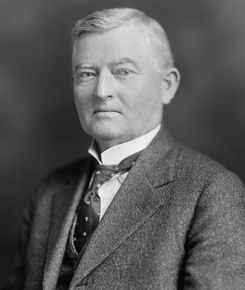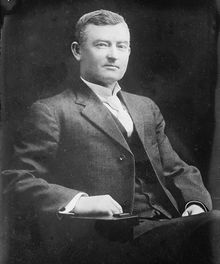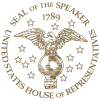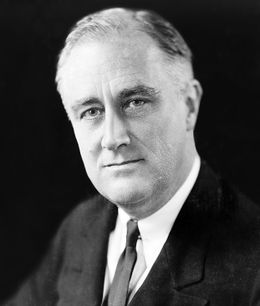John Nance Garner
| John Nance Garner | |
 |
|
|
|
|
|---|---|
| In office March 4, 1933 – January 20, 1941 |
|
| President | Franklin D. Roosevelt |
| Preceded by | Charles Curtis |
| Succeeded by | Henry A. Wallace |
|
|
|
| In office December 7, 1931 – March 4, 1933 |
|
| President | Herbert Hoover |
| Preceded by | Nicholas Longworth |
| Succeeded by | Henry T. Rainey |
|
8th Minority Leader of the United States House of Representatives
|
|
| In office 1929–1931 |
|
| Deputy | William Allan Oldfield (whip) |
| Preceded by | Finis Garrett |
| Succeeded by | Bertrand Snell |
|
Member of the U.S. House of Representatives
from 's Texas' 15th district |
|
| In office March 4, 1903 – March 4, 1933 |
|
| Preceded by | new district |
| Succeeded by | Milton H. West |
|
|
|
| Born | November 22, 1868 Red River County, Texas United States |
| Died | November 7, 1967 (aged 98) Uvalde, Texas United States |
| Nationality | American |
| Political party | Democratic |
| Spouse(s) | Mariette Rheiner Garner |
| Children | Tully Charles Garner |
| Alma mater | Vanderbilt University - dropped out |
| Religion | Methodist |
| Signature | |
John Nance Garner IV, nicknamed "Cactus Jack" (November 22, 1868 – November 7, 1967), was the 44th Speaker of the United States House of Representatives (1931–33) and the 32nd Vice President of the United States (1933–41).
Contents |
Early life and family
Garner was born near Detroit in Red River County in East Texas, to John Nance Garner, III, and his wife, the former Sarah Jane Guest.[1] Garner attended Vanderbilt University for one semester before dropping out and returning home. He eventually studied law, was admitted to the bar in 1890, and began practice in Uvalde, Uvalde County, Texas. He was county judge of Uvalde County from 1893 to 1896. (Although the county judge in Texas is now primarily the chief administrative officer of a county, comparable to the mayor of a city, the office is a Judicial position and the county judge sits in small civil cases, misdemeanor criminal cases, and probate cases.) In the 1893 campaign for Uvalde County Judge, his Democratic primary opponent was Mariette Rheiner, a rancher's daughter. He married her two years later, and they had one child, a son, Tully Charles Garner, two grandsons, Tully of Fredricksburg Texas and John, and one granddaughter, Jean Venette Garner married to Clarence Brewer Price, one great granddaughter, Tracy Denise Greenwood married to John Alexander Greenwood, and three great great grandchildren, Andrea Ashley Greenwood, Cory Alexander Greenwood, and Nolan Brewer Greenwood.
Texas politics
Garner was a member of the Texas State House of Representatives from 1898 to 1902. While in the Texas Legislature, a bill came up to select a state flower for Texas. Garner fervently supported the prickly pear cactus for the honor and earned the nickname "Cactus Jack" for his effort. The bluebonnet eventually won out and was chosen as the state flower.
Garner was elected as a Democrat to the United States House of Representatives in 1902 from a newly created congressional district covering tens of thousands of square miles of rural South Texas. He was elected from the district fourteen subsequent times, serving until 1933. His wife served as his private secretary during this period.

Garner's hard work and integrity made him a respected leader in the House, and he was chosen to serve as minority floor leader for the Democrats in 1929, and then as Speaker of the United States House of Representatives in 1931.
Garner was a supporter of the federal income tax but opposed most tariffs except for those on wool and mohair, important to his Texas base. He was also a pork barrel spender who aimed to bring popular projects to his district.[2]
Popular with his fellow House members in both parties, Garner held what he called his "board of education" during the era of prohibition, a gathering spot for lawmakers to drink alcohol, or as Garner called it, "strike a blow for liberty." The "board of education" was continued after prohibition had ended by future Democratic Speaker Sam Rayburn, a Tennessee native from Bonham, Texas.[2] According to the historian Patrick Cox of the University of Texas, prohibition became a major but almost forgotten issue in the 1932 campaign in which Franklin D. Roosevelt, with Garner as his running mate, defeated the Republican Hoover-Curtis ticket.[2]
Vice Presidency
In 1932, Garner ran for the Democratic presidential nomination against New York Governor Franklin Roosevelt. When it became evident that Roosevelt was the strongest of several candidates, although he had not yet received a majority of delegates (thanks to opposition figures, in spite of receiving most of the popular support), Garner cut a deal with the front-runner, becoming Roosevelt's vice-presidential candidate. He was re-elected to the Seventy-third Congress on November 8, 1932, and on the same day was elected Vice President of the United States, making him the only man to serve as both Speaker Of The House and President Of The Senate on the same day (March 4, 1933). He was re-elected Vice President in 1936 and served in that office from March 4, 1933, to January 20, 1941. Garner once described the vice presidency as being "not worth a bucket of warm piss."[3] This quote was bowdlerized for many decades to "not worth a bucket of warm spit" by the media. The incorrect version is still used on occasion.[4] Garner once described a writer who quoted it this way as a "pantywaist."[5]
During Roosevelt's second term, the previously warm relationship between Garner and Roosevelt quickly soured, as Garner disagreed sharply with Roosevelt on a wide range of important issues. Garner supported federal intervention to break up the Flint Sit-Down Strike, supported a balanced federal budget, opposed packing the Supreme Court with additional judges, and opposed executive interference with the internal business of the Congress.
During 1938 and 1939, numerous Democratic party leaders urged Garner to run for President in 1940. Garner saw himself as the champion of the traditional Democratic Party establishment, which often clashed with supporters of Roosevelt's New Deal. The Gallup poll showed that Garner was the favorite among Democratic voters, presuming that Roosevelt would defer to the longstanding two-term tradition and not run for a third term. Time magazine characterized him in April 15, 1940:
- "Cactus Jack is 71, sound in wind & limb, a hickory conservative who does not represent the Old South of magnolias, hoopskirts, pillared verandas, but the New South: moneymaking, industrial, hardboiled, still expanding too rapidly to brood over social problems. He stands for oil derricks, sheriffs who use airplanes, prairie skyscrapers, mechanized farms, $100 Stetson hats. Conservative John Garner appeals to many a conservative voter."[6]
But Garner did not appeal to liberals. Union leader John L. Lewis testified before Congress that Garner was a "a labor-baiting, poker-playing, whiskey-drinking, evil old man."[7]
Roosevelt quietly made it known that he would seek a third term. Even though this decision made it highly unlikely that Garner would win the nomination, he stayed in the race anyway, because he opposed much of what the President stood for, and opposed the idea of anyone having a third term as President. Roosevelt easily won re-nomination at the Democratic National Convention on the first ballot and chose Henry A. Wallace to be his running mate, leaving Garner without an office.
Later life and legacy
Garner stepped down as Vice President in January 1941, ending a 46-year career in public life. He retired to his home in Uvalde for the last 26 years of his life, where he managed his extensive real estate holdings, spent time with his great-grandchildren, and fished. Throughout his retirement, he was consulted by active Democratic politicians, and was especially close to Harry S. Truman.
On the morning of Garner's 95th birthday on November 22, 1963, President John F. Kennedy called from Fort Worth, to wish the former Vice President a happy birthday, just before his fateful trip to Dallas.
Garner died at the age of 98. Having lived 98 years and 350 days gave him the record as the longest-living Vice-President in United States history, which was previously held by Vice President Levi P. Morton. Garner still holds that record as of 2010. He is interred in Uvalde Cemetery.
Garner and Schuyler Colfax are the only two Vice Presidents to have been Speaker of the House of Representatives prior to becoming Vice President. As the Vice President is also the President of the Senate, this means that Garner and Colfax are the only people in history to have served as the presiding officer of both houses of Congress.
Garner State Park, located 30 miles (48 km) north of Uvalde, Texas, was named in his honor.
References
- ↑ [1]
- ↑ 2.0 2.1 2.2 Patrick Cox, University of Texas, "John Nance Garner", West Texas Historical Association joint meeting with the East Texas Historical Commission at Fort Worth, February 26, 2010
- ↑ Blumenthal, Sidney (2007-06-28). "The imperial vice presidency". Salon.com. http://www.salon.com/opinion/blumenthal/2007/06/28/cheney/. Retrieved 2007-09-22.
- ↑ Freedlander, David. "Who will Barack Obama choose as VP?". Newsday.com. http://www.newsday.com/long-island/who-will-barack-obama-choose-as-vp-1.882915. Retrieved 2009-11-08.
- ↑ Alter, Jonathan (2006-02-27). "The Imperial (Vice) Presidency". Newsweek. http://www.newsweek.com/id/56898. Retrieved 2008-08-05.
- ↑ see online
- ↑ Time Aug 7, 1939
John Nance Garner's cousin, Hamilton Garner from Illinois, had a grandson who lives in Tucson, Arizona and is also named John Garner.
Sources
- John Nance Garner at the Biographical Directory of the United States Congress
- John Nance Garner at Find A Grave
- Champagne, Anthony. "John Nance Garner," in Raymond W Smock and Susan W Hammond, eds. Masters of the House: Congressional Leadership Over Two Centuries (1998) pp 144–80
- Timmons, Bascom N. Garner of Texas: A Personal History. 1948.
- Will, George. "In Cactus Jack's Footsteps". Jewish World Review 6 Jan. 2000.
| Political offices | ||
|---|---|---|
| Preceded by Charles Curtis |
Vice President of the United States March 4, 1933 – January 20, 1941 |
Succeeded by Henry A. Wallace |
| Preceded by Nicholas Longworth |
Speaker of the United States House of Representatives December 7, 1931 – March 4, 1933 |
Succeeded by Henry T. Rainey |
| Preceded by Finis Garrett |
Minority Leader of the United States House of Representatives March 4, 1929 - December 7, 1931 |
Succeeded by Bertrand Snell |
| United States House of Representatives | ||
| Preceded by New district |
Member of the U.S. House of Representatives from Texas's 15th congressional district March 4, 1903 – March 4, 1933 |
Succeeded by Milton H. West |
| Party political offices | ||
| Preceded by Joseph Taylor Robinson |
Democratic Party vice presidential candidate 1932, 1936 |
Succeeded by Henry A. Wallace |
| Preceded by Finis Garrett |
House Democratic Leader 1929 - 1931 |
Succeeded by Henry T. Rainey |
|
|||||||||
|
|||||||
|
|||||||||||||||||||||||||
|
|||||||||||||||||||||||||||||||||||||



